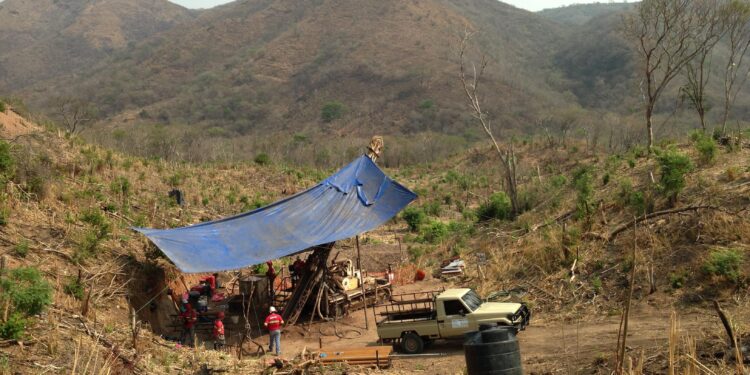Condor Gold (AIM: CNR; TSX: COG) has obtained significant assay results from the sampling of geotechnical drill holes on the La India Open Pit in Nicaragua. These intercepts are located within and between the planned high-grade starter pits and provide additional confidence to the mineral resource in this key area.
Highlights:
- 34.1 m true width at 2.56 g/t gold amalgamated from 2.80 m drill depth including 6.0 m at 4.3 g/t gold, 2.0 m at 5.3 g/t gold and 3.65m at 8.75g/t gold (drill hole LIGT536), located within the planned Northern Starter Pit.
- 28.7 m true width at 2.62 g/t gold in the hanging-wall of historic mine workings (drill hole LIGT528).
- 5.3 m true width at 3.11 g/t gold from 36.00 m drill depth, and 5.1 m true width at 2.70 g/t gold from 51.45 m drill depth in drill hole LIGT531; located in an area that has previously been interpreted as a low-grade zone between two high-grade shoots that host the planned starter pits.
“A wide zone of 34.1 metres true width of good open pit grade gold mineralisation of 2.56 g/t gold from only 2.80 metres drill depth is ideal material as initial mill feed for the permitted processing plant and supports the attractive project economics and 12 month pay back detailed in the PEA technical report filed in October 2021,” Chairman and CEO, Mark Child, said.
“This was a geotechnical drill hole within La India open pit that was initially surveyed and analysed for structures and rock strength, which once completed, was assayed for gold and silver.
“It adds confidence to the geological model for the forthcoming Feasibility Study and serves as a timely reminder of the wide zones of material with good open pit gold grade available near surface within the fully permitted La India Project.”
Background
Condor announced the completion of 21 geotechnical drill holes on the planned La India Open Pit in an RNS dated 30th November 2021. The drilling was designed to provide drill core samples through all sides of the pit wall in order to collect geotechnical information to analyse and to determine the geotechnical parameters for the final pit design to a Feasibility Study (FS) level of detail, which is to plus or minus 15% accuracy.
In all cases the drill holes were collared within the open pit shell and angled to pass through the pit wall at a pre-determined location in order to sample the rock mass that will eventually form the pit wall. T
hree of the geotechnical holes were drilled through the principal La India mineralised zone to test the pit walls on the footwall side of the pit. The drill core collected through the mineralised zone effectively provides additional infill drill samples, and this material was assayed after the geotechnical test work had been completed.
Assay results
The twin geotechnical drill holes LIGT528 and LIGT536 have provided a useful additional infill in the planned Northern Starter Pit. The drill holes returned similar intercepts of 41.05 m (28.7 m true width) at 2.62 g/t gold and 44.85 m (30.2 m true width) at 2.55 g/t gold in the hanging-wall of the historic mine workings.
Of these only LIGT536 successfully drilled into the historic mine footwall to return an amalgamated hangingwall and footwall intercept of 50.70 m (34.1 m true width) at 2.56 g/t gold from 2.80 m drill depth.
This intercept includes three high-grade veins in the hanging-wall of 6.0 m true width at 4.30 g/t gold, 2.0 m true width at 5.31 g/t gold and 3.6 m true width at 8.75 g/t gold, as well as a 3 m wide mine cavity (see table below). These twin holes have returned the eighth and tenth best intercepts to-date on the La India Vein/
Geotechnical drill hole LIGT531 was drilled 150 m along strike to the southwest in the zone between the two planned starter pits.
The assay results confirmed significant mineralisation at depth between the two starter pits in the segment where the La India Vein splits in two: returning significant intercepts of 7.60 m (5.3 m true width) at 3.11 g/t gold from 36.00 m drill depth (the upper La India vein), and 7.35 m (5.1 m true width) at 2.70 g/t gold from 51.45 m drill depth (the lower La India vein). These assay results add confidence to the geological model.
For further information please visit: http://www.condorgold.com/












